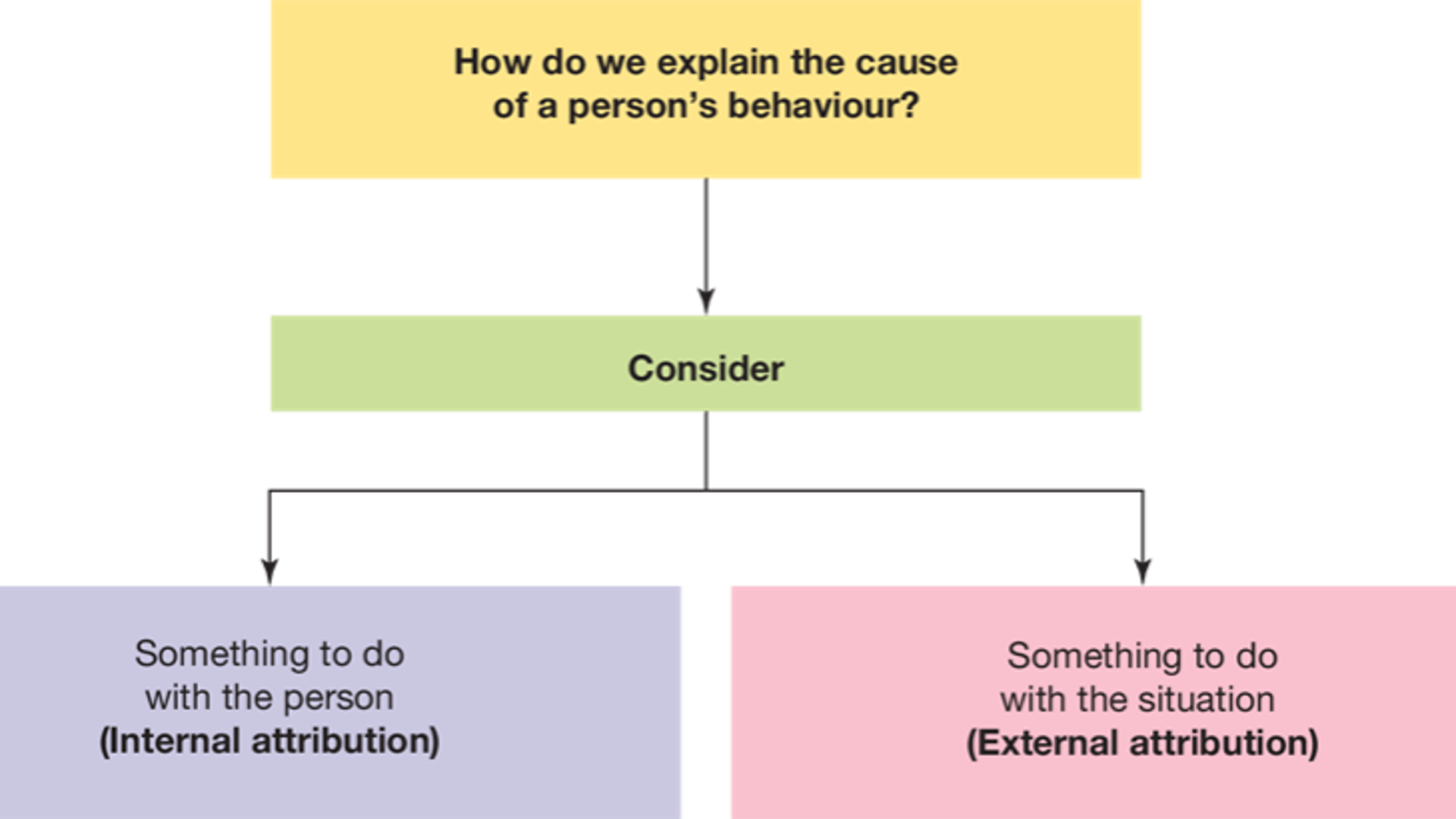SOCIAL COGNITION
1/41
Earn XP
Description and Tags
Unit 2
Name | Mastery | Learn | Test | Matching | Spaced |
|---|
No study sessions yet.
42 Terms
Social cognition
Involves how we perceive, think about and use information to understand and make judgements about ourselves and others in different situations
Person perception
refers to the mental processes we use to think about and evaluate other people
The process of forming impressions about others
What influences person perception
Physical cues
Halo effect
Behaviour
Body language
Physical cues
The way people look and the way they act
What is the Halo effect:
The tendency to allow our overall positive impression of a person, or our positive impression of a specific quality, to influence our beliefs and expectations about the person in other qualities.
How do people communicate through body language?
We often communicate inner aspects of ourselves through facial expression, eye gaze, posture, gestures, and other bodily movements.
One of the most influential forms of nonverbal communication is
Eye contact
How does behaviour form impresssions
Behaviour forms impressions through what we observe in ourselves and also what we hear about others, including verbal communication
What is salience detection?
Refers to any personal characteristic that is distinctive, prominent, conspicuous, or noteable it its context and therefore attracts attention.
Examples of salience detection
age
gender
race
physical appearance in general
specific features
When may perceptions differ
Situationally
What is social categorisation
When a person perceives, we routinely classify each other into different groups on the basis of common characteristics
What is the ingroup
Allport (1954) described ingroup as any group you belong to or identify with
What is outgroup
Allport (1954) described the outgroup as any group you do not belong to or identify with
An attribution is
An evaluation about the causes of behaviour and the process of making this evaluation

How do we explain the cause of a person’s behaviour?
By considering if it had:
Something to do with the person (internal attribution)
Something to do with the situation (external attribution)

Internal attribution occurs..
When we judge behaviour as being caused by something personal within an individual.
Internal attributions include judging behaviour as a result of someones:
• psychological state
• age
• gender
• intellect
• motivation
• ability
• desire
• past behaviour.
External attribution occurs…
When we determine the cause of behaviour as resulting from situational factors occurring outside the individual.
Situational factors include:
The environment a person is in when they produce a behaviour
Events experienced beyond their control (E.g: emergencies and actions of another person)
What is fundamental attribution error?
Refers to tour tendency to explain other people’s behaviour in terms of internal factors, whilst ignoring possible external factors.
What is actor-observer bias?
Refers to our tendency to attribute our own behaviour to external or situational factors, yet attribute others’ behaviours to internal factors.
Examples of biases affecting attributions are..
Fundamental attribution error
Actor-observer bias
Self-serving bias is
a type of self-deception where we judge ourselves we tend to take the credit for our successes and deny responsibility for failure, which is blamed on external, situational factors.
What are attitudes?
Refers to the evaluation and learned ideas of something, may be a person, object, event, or idea

What is the tri-component model of attitudes?
Proposes that any attitude has three related components, sometimes called ‘ABCs of attitudes’
“ABCs of attitudes“ - A
Affective component of an attitude refers to the emotional reactions or feelings and individual has towards an object, person, group or event or issue
Tri-component model of attitudes - behavioural component
The behavioural component of an attitude refers to the way in which an attitude is expressed through our actions (or how we might behave)
Tri-component model of attitudes the cognitive component
the cognitive component of an attitude refers to the beliefs we have about an object, person, group event or issue.
identify these as either the Affective component, Behavioural component, Cognitive component of an attitude:
•I like chocolate
•Eating salad
•Believing the tooth fairy is real
•Moving away from a spider
•I’m scared of spiders
•I think spiders could hurt me
A
B
C
B
A
C
List the three parts of the tri-component model of attitudes & the main idea
Affective component - emotional reactions or feelings
Behavioural component - actions
Cognitive component - beliefs
Limitations of the Tri-component model
Many psychologists suggest that only the affective and cognitive components need to be present for an attitude to exist.
Argue this as many circumstances a person’s behaviour does not or cannot reflect their attitudes.
What is a stereotype?
A collection of beliefs that we have about the people who belong to a certain group
Why may stereotypes be used?
Used as a cognitive tool to allow for quick and efficient judgements about the social world. First impressions tend to be lasting.
efficiency comes at the cost of accuracy.
Social stigma
Negative labels and attitudes associated with disapproval or rejection by others who are not labelled in that way.
People who experience social stigma may then expeerince…
Unfair discrimination
Feel like outcast who are devalued, ignored and rejected by others simply because they are members of the stigmatised group.
The 3 ways attitudes may be formed
direct contact child rearing, and group membership.
How are attitudes formed through direct contact
Personal experiences with the object of the attitude
how are attitudes formed through child rearing
Parental values, beliefs and practices applied when carring for a child
How are attitudes formed through group membership
our association with the people with whom we share common characteristics
Limitations of the tricomponent model
Model does not:
Indicate strength of an attitude
Include ambivalent attitudes (ambivalence: no strong +ve or -ve feeling, easily swayed)
Cognitive dissonance (when behaviour doesn’t match thoughts & feelings)
Take into account that frequently acessed attitudes are more likely to guide behaviour